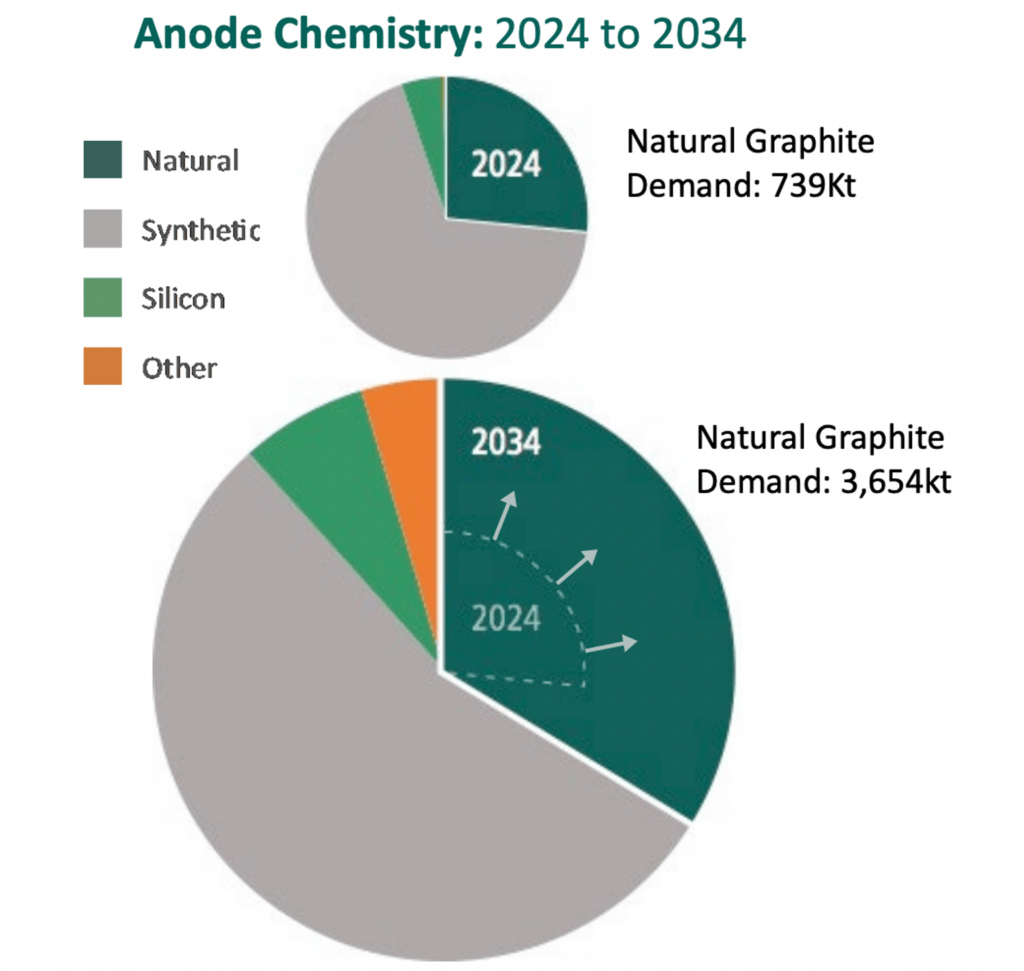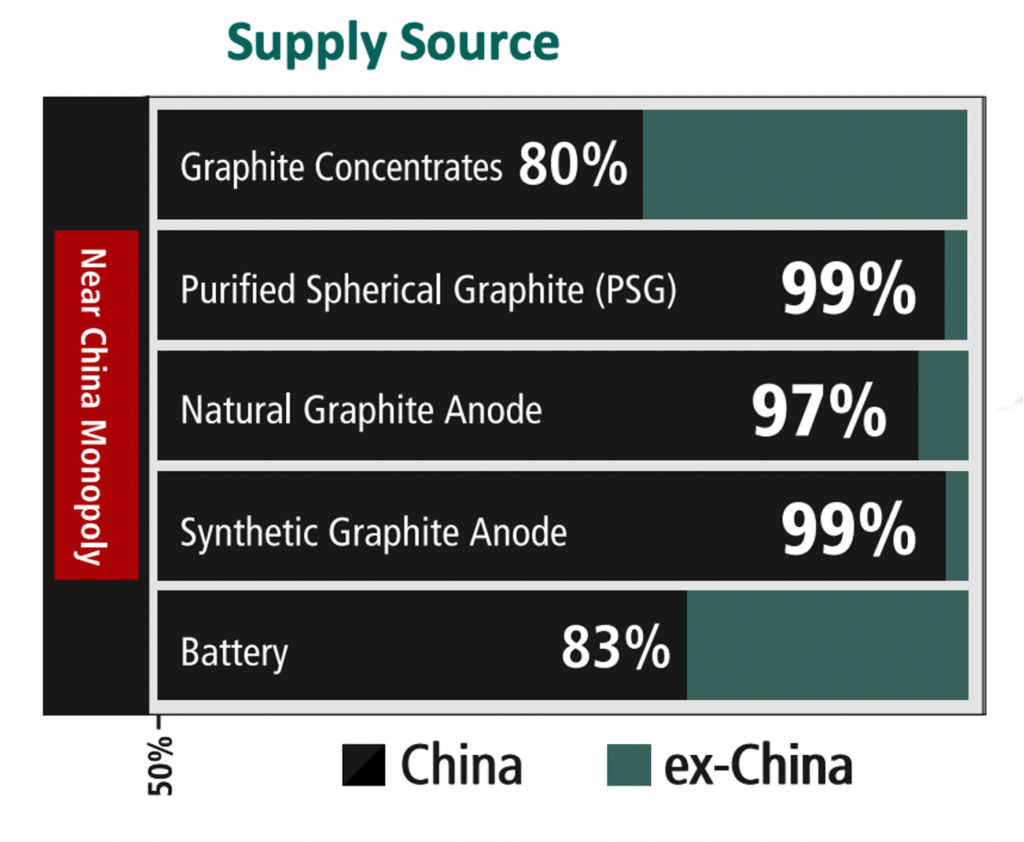Graphite slips under radar as China puts foot on critical minerals supply chain
Graphite is vital for EV anodes, but has slipped under the radar when it comes to attempts to break China’s critical minerals stranglehold.

Stockhead
Don't miss out on the headlines from Stockhead. Followed categories will be added to My News.
Move over rare earths, graphite is a key critical mineral too
China dominates supply, pushing governments to shore up domestic graphite
These ASX stocks could be well placed to secure a spot in the supply chain
Rare earths have been in the spotlight lately with the US/China tariff trade war highlighting the need for Western countries to shore up domestic supply chains, particularly around minerals critical to defence and tech applications.
But one mineral that's slipped under the radar is graphite.
China also has a stranglehold on global graphite supply, but that could present opportunities for ASX stocks with a near-term development projects.
Graphite is crucial in lithium-ion batteries, acting as the anode material. In fact, there's more graphite in a lithium-ion battery than there is the eponymous lithium.
There are plenty of Aussie players with deposits waiting for their breakout moment. Buxton Resources' (ASX:BUX) Graphite Bull project in WA is one that has the potential to be a supplier of choice for natural flake graphite for lithium-ion battery manufacturers.
CEO Martin Moloney says investors have realised China has a dominant position in the supply chain. In the midst of the uncertainty in the market and China’s influence on the supply chain, Buxton’s approach has been to take the project as far as they can, declaring a resource, doing baseline environmental studies and essentially bringing it to a pre-scoping stage.
"We looked at our graphite project and wanted to know could it work as an anode and could we make it a lot bigger,” Moloney said.
“Unequivocally, we've answered those with a resounding yes, it works particularly well as an active anode material.“
He also notes that the high grade of the project, and its location in Australia are beneficial in terms of trading with the US.
We’re going to need both synthetic and natural
Then there’s the synthetics vs natural flake debate. There are pros and cons, Moloney says synthetic is good because it's consistent, and natural is also good, because it has this extra crystallinity that gives more charge density.
He also reckons anode manufacturers like Chinese anode manufacturer BTR, who are undertaking qualification testwork on the company’s ore, would rather have a blend of the two. But pricing might impact that.
“The prices of the feedstock for the synthetic graphite have gone through the roof, so it's going to be very difficult for synthetic graphite to remain at ... rock bottom prices,” he said.
“And so consumers, the people making the anodes, are going to start biassing more towards natural because there's this just inherent price advantage there.
“The synthetic market is also massively oversupplied, so what that has meant is that recently a lot of manufacturers of synthetic graphite in China have started falling by the wayside.
“Now, that capacity could come back online relatively quickly, but still just goes to show that the prices currently are not sustainable.”
However, there's a fundamental supply deficit for natural graphite too, particularly outside of China.
“And because retail stock market punters have not been backing graphite stocks, there's this looming structural deficit in the natural graphite market,” Moloney said.
“For all the reasons, synthetic's not going to displace it and the other alternative chemistries of anodes aren't going to displace it either.
“So, the future market is kind of bright for natural graphite, particularly if you have the extra advantages of being in Australia.”

But realistically, he doesn’t think countries will be able to secure supply outside of China in the near-future, and then only if Governments get involved.
“It'd be great to supply a future in 10 years, but actually we need to supply our future in one year, or to buffer in the short term,” Moloney said.
“So, they're not really motivated, but if they've got Governments forcing them, like what Trump's doing with the tariffs, then government intervention is absolutely required because government intervention is basically what's created the problem in the first place.”
Shore up supply chain like South Korea
Renascor Resources (ASX:RNU) MD David Christensen thinks graphite’s importance as a critical mineral is definitely being undervalued at the moment.
The company’s Siviour project in South Australia has a post-tax net present value of $1.5 billion and Renascor expects it to be one of the world’s lowest cost projects, with costs of US$405/t of graphite concentrate in the first 10 years.
The company is also advancing optimisation studies and is also looking to commission a purified spherical graphite (PSG) demonstration plant later this year.
“Over the last several years, China has increased its dominance in the production and refining of graphite to the point of having monopoly control of portions of the graphite supply chain,” Christensen said.
“This means that the production of EVs in the US (or any other country) is wholly dependent on China for graphite.
“The recent trade tension highlights the need for secure supply chains for graphite to ensure the EV industry can continue to grow, notwithstanding the current trade tension.”
He reckons we should take a leaf out of South Korea’s book with POSCO, a company primarily known for its steel manufacturing, becoming increasingly involved in the EV industry. It's been expanding and investing in that arm of the business – including cathode and anode materials, as well as producing steel for EV components.
“South Korea has been the leader outside of China in building out mid and downstream manufacturing capacity in the battery sector,” Christensen said.
“It is no surprise that POSCO is expanding its manufacturing footprint in Korea to free itself of dependence on China.
“To protect domestic manufacturing investments in the battery/EV space, I think we can expect to see similar investments outside of South Korea, including in Japan, which already has established anode producers, as well as the US and EU which have seen significant investment in battery production.”

And a scramble is already on to build anode manufacturing capacity outside China.
“Whilst the equity markets have been soft for graphite (as well as other battery minerals) in recent times, we are already seeing significant ex-China expansions by anode makers, who require graphite for their operations,” Christensen said.
“The legacy ex-China anode makers in South Korea and Japan have announced major expansions, and we are seeing some of the tier-1 Chinese anode makers make major investments in Indonesia, Malaysia and Morrocco.
“The one common theme for all of these projects is that they will need graphite sourced outside of China.”
Who else has a graphite play?
Green Critical Minerals (ASX:GCM)
The company has been steadily demonstrating the potential of its VHD Graphite technology to meet the needs of industries requiring next-generation advanced engineered graphite and thermal solutions.
Its technology has consistently manufactured a product with the highest density (2071kg/m3) recorded for VHD blocks while the average density of 2011kg/m3 easily exceeds industry standard densities for nuclear graphite (1700-1900kg/m3), which is used as a high-temperature control-rod material, and electrode graphite (1550-1800kg/m3) used in batteries.
Testing also found that its VHD Graphite blocks had 3x better thermal diffusivity than aluminium and graphite, 2.6x better than copper as well as a 25x directional advantage.
Just last week, GCM signed a collaboration agreement with Australian data centre operator GreenSquareDC highlighting commercial interest in its very high density (VHD) graphite.
Under the agreement, which is part of an ongoing targeted customer qualification and engagement program, the companies will collaborate in the development and provision of thermal management products for GreenSquareDC’s data centres using VHD Graphite.
Sovereign Metals (ASX:SVM)
SVM has the Kasiya project in Malawi, the only known natural graphite and rutile project.
In February, the company reported that testwork on its graphite either met or exceeded specifications required for use in the expandable and expanded graphite markets.
The results can now be used for customer engagement and potential offtake to another two markets, where demand from flame retardants and gaskets, seals and brake linings is approaching 100,000t a year and expanding at a compound annual growth clip of 6-8%.
SVM has already shown it can supply material suited for the two largest natural graphite markets, battery anodes and refractories, used in steelmaking,
Plus, in January, an optimised PFS reaffirmed the project’s globally strategic significance, and potential to become one of the largest and lowest-cost producer of natural rutile and natural flake graphite while generating exceptional economics.
Rio Tinto (ASX:RIO) is sitting in the background with a major stake of close to 20%, putting a big target on Sovereign's back.
Kingsland Minerals (ASX:KNG)
KNG’s Leliyn project in the NT is Australia's largest graphite deposit with a resource of 194.6Mt at 7.3% total graphitic carbon. Above and beyond that is an exploration target of 700Mt to 1.1 billion tonnes at 7-8% TGC.
The company recently sent a bulk sample of concentrate to Germany for extensive metallurgical tests to produce purified spherical graphite, with the results to feed into a scoping study into the production of fine flake graphite.
KNG expects Leliyn to be low-cost, as the large, shallow nature of the orebody is likely to lead to a low strip ratio.
Notably, the company is backed by new 15.3% shareholder Quinbrook Infrastructure Partners and together the pair are looking at developing downstream processing capacity in Darwin.
At Stockhead, we tell it like it is. While Buxton Resources, Renascor Resources, Green Critical Minerals, Sovereign Metals and Kingsland Minerals are Stockhead advertisers, they did not sponsor this article.
Originally published as Graphite slips under radar as China puts foot on critical minerals supply chain






